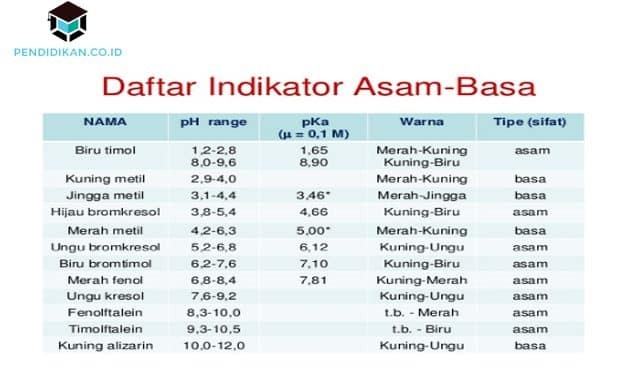Understanding Acid-Base Indicators, Types and Examples
Education. Co. ID – When we will discuss the Definition of Acid-Base Indicators, below is an explanation of the Definition of Acid-Base Indicators along with types and examples:

Understanding Acid-Base Indicators
This acid and base solution will give a certain color when reacted with an indicator. An indicator is a complex compound that can or can react with acid-base compounds.
Through indicators, we will be able to determine whether a substance is acidic or basic. The indicator can also be used to determine the strength level of an acid or base.
Some of the indicators are made from natural ingredients, but there are also some indicators that are synthetically made in the laboratory. The following types of acid-base indicators are included examples.
Types of Acid-Base Indicators
Below are the types of indicators that are most widely used, including the following:
1. Litmus Paper
The indicator that is often available in a laboratory is litmus paper, because this type of indicator is more practical and also because the price is relatively cheap. There are two types of litmus paper, namely red litmus and blue litmus.
These acid-base compounds can be identified using litmus paper by observing the color change of the litmus paper when it reacts with the solution. In an acidic solution, the litmus paper is always red, while in an alkaline solution, the litmus paper is always blue.
Thus, the acid solution will change the color of the blue litmus paper to red and the alkaline solution will change the color of the red litmus paper to blue. In a neutral solution (salt), the color of this litmus paper does not show a change (red remains red and blue remains blue).
2. Natural Indicator
Some are types of plants and can be used as natural indicators, for example purple cabbage, mangosteen peel, hibiscus flowers, bougainvillea flowers, water henna, and turmeric.

3. Indicator Solution
The indicator solution is one of the types of indicators that can be used to determine the acid-base properties of a compound. To be able to detect the acid-base properties of a substance, an indicator is generally used in the form of solution, because with an indicator solution, the nature of the acid and base carriers becomes easier to detect detected.
Indicators that are often used in the laboratory are:
- Phenolphthalein (PP) indicator solution
- methyl red (mm),
- methyl orange (mo), and also
- bromthymol blue (BTB).
The following are some other pH indicators that are also often used in a laboratory. The indicators below show a change in the color of the solution in a certain range of pH values.

4. PH meter
The pH meter can be used as a tool for measuring the pH of a solution quickly and accurately. This pH meter has an electrode that can be dipped in an acid-base solution whose pH value will be measured. The pH value can be easily seen directly by going through the numbers listed on the digital screen of the pH meter itself.
5. Universal Indicator
One of the indicators that has or has a good level of confidence is a universal indicator. This universal indicator is an indicator that consists of various indicators with different colors for each pH value between 1 – 14. There are universal indicators in the form of a solution and some are in the form of paper. The universal indicator package is always equipped with a standard color for pH 1 – 14.

How to use this universal indicator is to dip the universal indicator paper in a the solution to be studied/investigated its pH value or drip universal indicator on a solution that detection. Next, just observe the color change that occurs and compare the color change with the standard color.
so much and thank you for reading about Understanding Acid Base Indicators, Types and Examples, Hopefully it can be useful for you.
See AlsoMetal Crafts: Definition, Types, History, Tools, Materials, and Procedures
See AlsoUnderstanding Andromeda Galaxy
See AlsoDefinition of Gastropods
